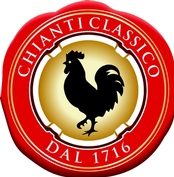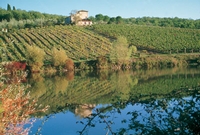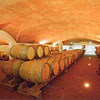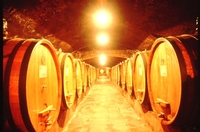Chianti is Italy’s most famous wine, and Chianti Classico is, by general consensus, its best Chianti. The region, located in the heart of the Chianti-producing zone in Tuscany, is the oldest and most prestigious area for Chianti. A wine called “Chianti” has been made there for at least 800 years--although the earliest wines were actually white.  Chianti has been only red for several hundred years--and today, in fact, no white grapes are now allowed in making Chianti Classico wine (as of 1996)--although up to 10 percent of white grapes are still allowed in other Chianti wines.
Chianti has been only red for several hundred years--and today, in fact, no white grapes are now allowed in making Chianti Classico wine (as of 1996)--although up to 10 percent of white grapes are still allowed in other Chianti wines.
At the heart of all Chianti wines is the Sangiovese grape variety. Perhaps more than any other grape, Sangiovese is extremely difficult to grow successfully. It is at its best only in the rolling hills of Tuscany, with its dry, fairly warm climate--but not every year by any means. Nowhere else in the world, including California, has Sangiovese really been successful.
Chianti Classico at its best is a very dry, medium-bodied red wine with a good amount of acidity, firm tannins, and tart cherry or berry flavors, with a dry finish. It is subtle and elegant, expressing more flavors at mid-palate and on the finish than at the front of the mouth (which is more typical of New World wines). As with all fine wines, Chianti Classico improves with bottle aging, up to 15 or 20 years in the better vintages.
Due to over-production and generally poor winemaking, Chianti wines went through a bad period after World War II, from the 1950s through  the 1970s--especially the Chianti wines made outside of the Chianti Classico zone. In an effort to distance itself from the rest of Chianti, in 1996 the Chianti Classico Consorzio managed to have laws passed giving Chianti Classico its own DOCG appellation, and just this year, 2010, Chianti Classico is now its own autonomous zone, completely apart from other Chianti wines.
the 1970s--especially the Chianti wines made outside of the Chianti Classico zone. In an effort to distance itself from the rest of Chianti, in 1996 the Chianti Classico Consorzio managed to have laws passed giving Chianti Classico its own DOCG appellation, and just this year, 2010, Chianti Classico is now its own autonomous zone, completely apart from other Chianti wines.
Of course, some good (non-Classico) Chianti wines are being made today (Frescobaldi and Selvapiana from the Chianti Rufina sub-zone come to mind), but the batting average for top Chianti is definitely higher for Chianti Classico wines as a group.
With all the improvements in viticulture and winemaking that have taken place in Tuscany during the last 30 years, you would think that Chianti Classico wines should be better than ever. But confusion still reigns in this region, regarding what type of wine Chianti Classico should be, and how the wine should actually be made. As a result, the consumer seldom knows what style of wine he or she is getting when Chianti Classico reaches the table.
As in other parts of the wine world, such as Bordeaux, California, and Piedmont, two general philosophical approaches to winemaking seem to exist in Chianti Classico:
1) The “Modern Wine” Approach begins with grapes that are thoroughly ripened before they are picked for making wine; the wines are fruity and delicious, with soft tannins and fairly low acidity; new barriques are used whenever possible to age the wines; the wines are dark in color, with over 14 percent alcohol; the use of Cabernet Sauvignon, Syrah, and/or Merlot up to 20 percent (permitted by law) is fine, and usually a plus for the wine.
thoroughly ripened before they are picked for making wine; the wines are fruity and delicious, with soft tannins and fairly low acidity; new barriques are used whenever possible to age the wines; the wines are dark in color, with over 14 percent alcohol; the use of Cabernet Sauvignon, Syrah, and/or Merlot up to 20 percent (permitted by law) is fine, and usually a plus for the wine.
2) The “Traditional” Approach does not necessarily demand  maximum ripeness the grapes prior to picking; the wine is crafted with the objective of making it balanced above all else, with a good amount of acidity to achieve that balance; barriques are used judiciously, but the wine’s aromas and flavors do not overtly reflect the use of oak; older, large barrels are as useful for aging as small new ones; the wine, mainly if not entirely made from Sangiovese, is not very dark in color, but rather a brilliant, transparent red; an alcohol level lower than 14 percent is desirable; international varieties such as Cabernet Sauvignon, Merlot, and Syrah are avoided whenever possible, because they change the taste and structure of Chianti Classico.
maximum ripeness the grapes prior to picking; the wine is crafted with the objective of making it balanced above all else, with a good amount of acidity to achieve that balance; barriques are used judiciously, but the wine’s aromas and flavors do not overtly reflect the use of oak; older, large barrels are as useful for aging as small new ones; the wine, mainly if not entirely made from Sangiovese, is not very dark in color, but rather a brilliant, transparent red; an alcohol level lower than 14 percent is desirable; international varieties such as Cabernet Sauvignon, Merlot, and Syrah are avoided whenever possible, because they change the taste and structure of Chianti Classico.
To no one’s surprise who knows me, I much prefer the traditional approach in Chianti Classico, as I do in Piedmont and Bordeaux. I’m happy to see that the pendulum has definitely swung back in Piedmont, and that traditional Piedmontese producers such as Giacomo Conterno, the Mascarellos, Giuseppe Rinaldi, and Bruno Giacosa are now regarded as the leaders in Barolo and Barbaresco.
Unfortunately, the modern approach is still very much the popular style in Chianti Classico today, although I am seeing signs of a return to traditional winemaking methods here as well.
It’s not all black or white, of course. Many producers manage to combine elements of both modern and traditional styles in their winemaking. I have in fact tasted a few Chianti Classicos from producers who favor the modern style that I have enjoyed. It’s the extreme examples that drive me up the wall: a Chianti which reeks of oak flavors, or some dark-colored behemoth of a wine that has absolutely no typicity of place, but is just another big, ripe, “international” wine on steroids.
What prompts wine producers to make such wines? Very simple: they want their wines to gain high point ratings from influential wine critics who favor what I’m calling--for lack of a better general term--the “modern” approach; some refer to it as the “international” style, but I think that term is too ambiguous.
The so-called “Super-Tuscan” wines that emerged in the late 1970s were good for Tuscany in general, but also had unfortunate side effects. Yes, some fine wines were produced, and continue to be made. No one can challenge the fact that the best Super-Tuscan wines, such as Sassicaia, Ornellaia, Masseto, Solaia, Sammarco, Le Pergole Torte, and Cepparello, are excellent wines. They attracted the attention of the international wine press, and attained high prices along with high ratings, but also created ripple effects that were problematic for Chianti Classico.
Suddenly, many Chianti Classico producers wanted to make more “important” wines, bigger, darker-colored wines--with the help of Cabernet Sauvignon, Merlot, and/or Syrah. Newer clones of Sangiovese were planted, which encouraged the production of richer, fleshier wines. Vineyards were planted with very high density, leading to lower yields and more concentrated grapes. In making this newer style of wine, these producers changed the face of Chianti-- giving the wine characteristics it previously did not possess.
An assessment of today’s stylistic situation should start with the grape variety composition of Chianti Classico, as it stands at present by law:
Sangiovese – 80 to 100 percent;
Other Approved Red Varieties – up to 20 percent (the main varieties being used are, in alphabetical order, Cabernet Sauvignon; Canaiolo; Colorino; Malvasia Nera; Mammolo; Merlot; Syrah).
No white grape varieties are allowed. If a producer chooses to use 20 percent of just one variety, such as Cabernet Sauvignon, he or she may do so.
The problem with this, in my view, is the fact that producers can use up to 20 percent of such powerful varieties as Cabernet Sauvignon, Merlot, and/or Syrah--all of which can overpower the more delicate Sangiovese variety, dominating the structure, aromas and flavors of the finished wine. Needless to say, these varieties will make the wine darker in color, which many modern producers regard as a positive effect. When riper, fleshier grapes, higher in alcohol, are part of the picture, along with aging in 100 percent new barriques, you get a wine that I can no longer recognize as Chianti Classico, but which will probably get high ratings from some wine critics.
I also have reservations regarding Chianti Classico Riservas, which are aged longer than Chianti Classicos, are more expensive, and theoretically should be higher quality wines than the standard Chianti Classicos. Many times the Riservas are also single-vineyard wines. However, the Riservas are also more likely to be aged in 100 percent new barriques, and are also more prone to have the aforementioned international varieties added to the blend. And so, ironically, I frequently prefer the less-expensive Classicos to the Riservas.
There are five important Chianti Classico geographical areas: from the north, Greve (including Panzano); Radda; Castellina; Gaiole; and Castelnuovo Berardanga. It is more difficult to make general statements about these areas than, say the areas of Bordeaux, because of differences in altitudes, hillsides, and so forth, within each zone. But I tend to favor the Chianti Classicos from the middle areas, Castellina , Gaiole, and Radda, (plus Panzano) by comparison to the cooler, lighter-bodied Greve Classicos or the bigger, more robust Chianti Classicos of Castelnuovo Berardenga in the southern part of the zone.
I have a short list of the Chianti Classicos I generally like. I’ll start with a former Chianti Classico that doesn’t label itself as such any more: Monte Vertine (in Radda). It’s traditionally made, intense, usually 100 percent Sangiovese, and it typically needs a few years of aging. It’s special. Other producers I admire:
--Castello dei Rampolla
--Fontodi, especially its Vigna del Sorbo Riserva (an exceptional Riserva)
--San Giusto a Rentennano
--Isole e Olena, especially its Cepparello IGT (100 percent Sangiovese)
--Castellare
--Il Palazzino
--Fattoria di Felsina
There are other fine Chianti Classicos, of course, but the above short list has had the virtue of consistency of quality. Some others, former favorites, have been getting a bit too ripe and fleshy for me lately.
You must pay attention to vintages in Chianti Classico. Here’s a brief rundown of the last five vintages generally available:
2003 – a hot vintage; wines generally lack elegance
2004 – the best of recent vintages; well-balanced
2005 – a light, precocious vintage; for current drinking
2006 – a warm year, producing big, powerful wines; 2004 is better
2007 – promises to be the best since 2004; well-balanced
Despite some of the problems I have mentioned about the current state of Chianti Classico, I do really like many of the wines. They tend to be moderately priced, and are excellent choices when I visit my favorite Italian restaurants, because they go so well with Italian cuisine!